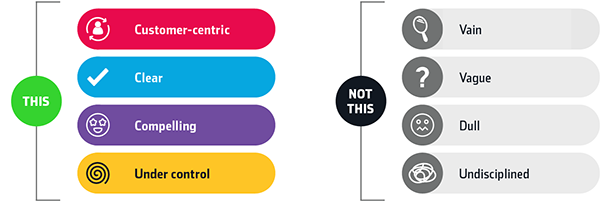On message strategy and more.
On message strategy and more.
You want customer-centric communication that’s clear, compelling, and under control. Right? But wait. What does “under control” even mean?
Short answer: It’s the opposite of “undisciplined.” Which is a primary indicator of bad marketing communication.

What a lack of brand management sounds like
Undisciplined communication is communication that suffers from a lack of control. Maybe you’ve never thought about in this particular way, but you’ve probably felt (or heard) the pain:
“The branches keep running ads with the wrong logo. Why is this so hard?”
“Our Twitter and Instagram feel like two different companies. Is it supposed to be that way?”
“The APAC region just launched their own website. What the heck?”
“That printer never gets our color right. Now we’ve got to reprint this entire run.”
“Our sales reps are building their own presentations. And they look like hell.”
“Why do they keep using images of men? Women suffer from this condition way more than men do.”
“We merged, and now we’ve got two cultures doing entirely different things. We don’t even know who we are.”
Any of this sound familiar? If so, your communication strategy needs a good dose of discipline. So let’s define that word.
What discipline means for your communication mix
The following definitions come from Merriam-Webster. (So do all the other definitions in this post.)
Discipline means:
Control gained by enforcing obedience or order
Orderly or prescribed conduct or pattern of behavior
Training that corrects, molds, or perfects
A rule or system of rules governing conduct or activity
See? Discipline and control go hand-in-hand. So if your marcom is undisciplined, you need to get it under control.
Specifically, “under control” means comms that check nine boxes:
- Accurate
- Compliant
- Specialized
- Branded
- Protected
- Consistent
- Sensitive
- Strategic
- Delivered
Let’s run through these, one by one.
Nine traits of orderly marketing communication
- 1. Accurate
Starting with the basics: proofreading. You probably know that if you’ve got typos, that makes your product quality sus, too. But you’ve got even bigger risks, right? Like the nightmare of having to honor incorrect pricing. Or listing a wrong phone number that turns out to be a sex line. (I’ve seen it happen.) To ensure accuracy, math should always be checked, phone numbers should always be called, facts should always be followed up on.

- 2. Compliant
It’s fun to hate on lawyers, but they’ve got a job to do. And at the end of the day, we all know that regulations are not suggestions. Plus now we’ve got all that GDPR stuff to worry about. Anyway, you shouldn’t have to remind your agency what can and can’t be said, and what disclaimers always have to be included. I mean really.
 Credit source: giphy.com
Credit source: giphy.com
- 3. Specialized
- In a generic sense, specialized means: Highly differentiated, especially in a particular direction or for a particular end
- Designed, trained, or fitted for one particular purpose or occupation
- In the context of message strategy, specialized means that the message is tailored to the medium. Here in Tennessee, we’d say it’s “done the way it’s supposed to be done for the medium it’s in.”
- So for example, if we’re creating an email for you, you expect us to know that the subject line should be 27 characters or fewer with keywords front-loaded, and to remember to write the preheader text. If we’re building you a website, you trust us to know best practices in SEO writing and UI/UX.
- If we’re designing a direct-mail piece for you, you count on us to keep postage costs in mind when we specify the dimensions of the piece and the weight of the paper. And so on.
- Because Counterpart is media-neutral, we consider it our duty to know the discipline of every medium… and to specialize your brand communication accordingly
- 4. Branded
All your marcom should look, feel, and sound like you. And there are two ways to accomplish this. Either all your communication is created by the same team. (Hey, how about us?) Or you establish brand guidelines that multiple teams adhere to. You don’t have to overthink these, but please do get those rules in writing. And don’t limit them to the logo. You need brand voice standards as much as you need visual ones.
- 5. Protected
Got intellectual property? It can only remain your property if what you publish consistently claims your ownership. Forget a few times, and the courts might decide you demonstrably don’t care about protecting it. So, always tack on that circle-R or TM, incorporate the copyright, and wrap up with “all rights reserved.”
- 6. Consistent
Communication that’s under control is consistent across all channels and touchpoints. Consistent in language. Consistent in tone. Consistent in color. Easier said than done, because nowadays your message appears in more media than ever.
 Credit source: giphy.com
Credit source: giphy.com
- 7. Sensitive
Like it or not, we have to worry about offending people these days. (Maybe not too much. I mean, we don’t advocate paranoia. But still.) And of course you want to represent diversity fairly. Plus you should be considerate of culture and language. Remember the Chevy Nova story? (Which isn’t true, by the way.)

- 8. Strategic
Invariably there’s a larger plan in effect. All your tactics should be aligned and answerable to the overarching business objective.
- 9. Delivered
In the words of my old boss (S/O Bret Terwilleger): “Anybody can do great work. The job is to do great work on time and on budget. That’s what makes you a professional.” Communication that’s under control means the agency that creates it for you delivers it when promised, and bills you for it as expected.
Four essentials for taming advertising and marketing communications
So, what does it take to create marcom that’s under control? Four things:
- Rules
- Communication
- Process
- Accountability
- 1. Rules
It all starts here. What does your brand stand for? What are the RGB values? Do you ever use humor? Do you prefer Chicago Style or AP? There are prescribed details, and there are overarching principles. Get it all defined and documented. That’s what brand standards are for.
- 2. Communication
Are you rules-ready? Good. Now everybody’s gotta know what they are. Marketing. Sales. Agencies. Vendors. So training, right? Obviously. But if you want the rules to stick, you need more than a one-and-done PowerPoint session. You need reminders. Think about a simple email campaign — a regular spotlight of best practices and issue-handling tips. This helps keep the importance of brand integrity top of mind.
- 3. Process
Getting your communication under control is one thing; keeping it that way is another. For that, you need a process. Who reviews your materials? How long should it take? Who approves them? How do you handle exceptions? Who’s keeping up with trademark renewal dates? There’s a lot to it once you start thinking about it.
- 4. Accountability
As with any responsibility, someone has to own it. It makes sense for you to own your brand in-house, doesn’t it? But if your people don’t have the bandwidth or the background, your brand might be better off in the hands of experts. Besides, accountability means consequences, and (just ask HR) it’s a lot easier to fire an outside resource than an internal one.
Tools for ensuring marcom discipline and control
To keep your marketing and communications in line, it helps to have frameworks and methodologies to follow. Google will turn up plenty. But at Counterpart, we’ve developed our own innovative ways to help you establish and maintain order in your communications.
Single Slide Strategy™ — A strategic framework that articulates your vision, belief, mission, values, and standards. Getting your entire organization on the same page? That’s discipline and control.
Position X® — A method for defining your value proposition in the marketplace… relative to your competition and your customer’s needs and perceptions. Having all your communication roll up to an overarching promise? That’s discipline and control.
Journey GPS™ — A graphic one-page model for a marcom plan, mapping tactics across the customer journey. Making sure your campaign is always developed within the context of customer behavior? That’s discipline and control.
Counterpart Brief™ — A dual-perspective approach to project-level message strategy. Ensuring proper empathy before you even attempt to engage? That’s discipline and control.
Strategic communications: Where you need control the most
We’ve been speaking in principles, but let’s get down to brass tacks. You’ve got a plan, a project, or a program that you need to produce. Consider the eight applications below. Think about each one, and ask yourself, could I use some discipline and control in this area?
- Strategic planning
- Value propositions
- Branding
- Marketing campaigns
- Content marketing
- SEO
- Web content development
- Sales enablement
Communication mastery means message strategy
It all comes back to this. Message strategy is “what you say and how you say it.” But another way to think about it is this: “Are we communicating the right thing the right way?” Ensuring that you are… that’s getting your marketing communication under control. And that’s a big part of what makes a message effective.




